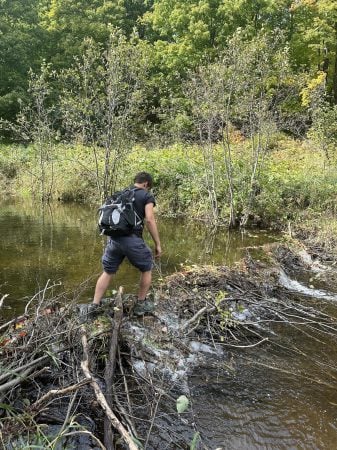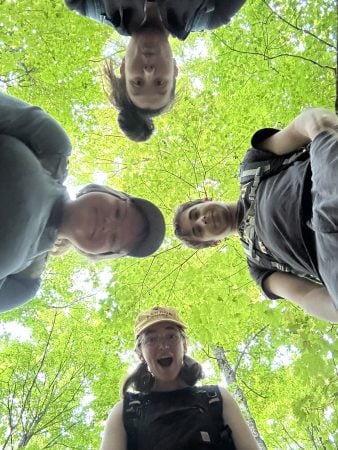
Huskies in the College of Forest Resources and Environmental Sciences care deeply about community and stewardship of natural resources. Allyson McQuiston, Aidan Sheppard, and Spencer Aud are no exception. Sheppard and Aud, both forestry majors, graduated in December 2024. McQuiston, an applied ecology and environmental science major, graduates this month. In this CFRES news blog, they describe their roles in a project designed to maintain and sustain the health of a treasured community resource.
Huskies Helping in the Hardwoods
Located 10 minutes south of downtown Houghton, Michigan, the Pilgrim River Community Forest encompasses around 1,600 acres of the Keweenaw’s well-known hardwood forest. This area serves as a community space for hiking, birdwatching, hunting, and fishing throughout all seasons.
Michigan Technological University forestry, wildlife, and ecology students have been working on their senior project, known as “capstone,” in this area. Groups of four to six students were assigned one to 200 acres of the Pilgrim Forest, with full liberty to create a final report about their findings and recommendations.

Led by Assistant Teaching Professor Jim Schmierer, students were given the freedom to take their
knowledge from their undergraduate experience and use it to focus on what interests them, with the ability to assess the land as they best see fit.
Annika Betz, a fourth-year applied ecology and environmental science major who graduated in December 2024, described her experience as a “showcase of our specialties.” Her group collected field data to demonstrate understory, overstory, and forest floor conditions. Betz said the approach was common among groups, although each took a different twist on their data analysis.
“Our group is focusing on the water quality of the Pilgrim River and how this impacts the wildlife. Invasive species have led to habitat loss, and we are trying to discover how the landowners could address this problem,” she said.
Each student group collected different data geared to the focus of their particular research. Topics included water quality, soil typing, tree merchantability, and signs of wildlife, the latter determined by footprints, scat, and photos.
McQuiston’s group collected tree diameters and heights, cataloged tree and plant species composition, and observed tree canopy cover, as well as documenting invasive species and forest health issues.
Though data collection was completed in October, students were not done. Students continuing the capstone work continued to analyze data throughout the spring semester.

“All of us presented our findings to our classmates and the community at the end of the spring semester,” said McQuiston. “Most groups recommended harvesting some of the overstory trees and allowing the understory to better develop, increasing the forest’s diversity. Next, we recommended where the trail system should be lengthened or expanded to better suit the community’s recreational needs. Also, we recommended removing the invasive species present, focusing on reed canary grass and glossy buckthorn.”
She said that while Huskies are understandably “eager to close the book on their undergraduate careers,” the importance of the project and the ties it created with the community remains.
“We all enjoyed getting to apply the knowledge we have learned over the years here at Michigan Tech, especially since it could benefit the surrounding community. It was fun to make this project our own, designing our data collection and management plans,” said McQuiston. “This work is important because the forest is ever-changing. Without proper management it will stop serving the needs of the wildlife present and the people of the area.”
Students Learn How to Communicate Their Research
McQuiston, Sheppard, and Aud wrote about their experiences studying the Pilgrim Community Forest as part of a project in FW4800, a natural resource communications course required for all CFRES seniors. We’re grateful to the students willing to share the communications projects they created for the class, taught by CFRES Assistant Professor Sarah Hoy, and look forward to featuring more of their stories in our CFRES news blog in the future.
About the College of Forest Resources and Environmental Science
Michigan Tech’s College of Forest Resources and Environmental Science brings students, faculty, and researchers together to measure, map, model, analyze, and deploy solutions. The College offers six bachelor’s degrees in forestry, wildlife ecology and conservation, applied ecology and environmental science, natural resources management, sustainable bioproducts, and environmental science and sustainability. We offer graduate degrees in applied ecology, forest ecology and management, forest molecular genetics and biotechnology, and forest science.
Questions? Contact us at forest@mtu.edu. Follow us on Facebook, Instagram, and LinkedIn for the latest happenings.